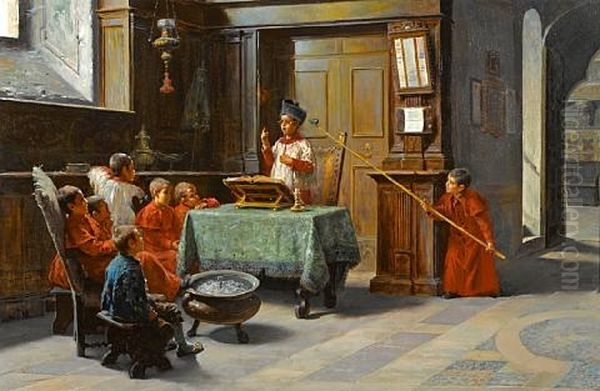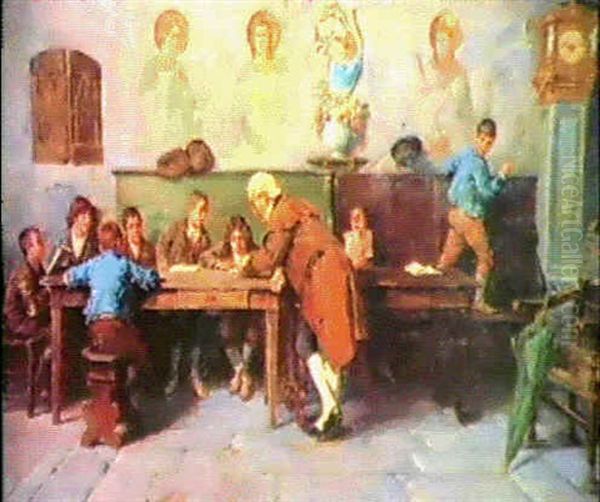Francesco Bergamini stands as a notable figure in the landscape of 19th-century Italian art. Born in 1815 and passing away in 1883, his career unfolded during a period of significant artistic transition in Italy and across Europe. As a painter, Bergamini dedicated himself primarily to the creation of intricate indoor genre scenes and works with religious themes, demonstrating a keen eye for narrative and detail. His contributions, while perhaps not as globally renowned as some of his contemporaries, offer valuable insight into the artistic currents and academic traditions of his time.
His formal training provided a strong foundation for his artistic endeavors. Bergamini honed his skills within the respected halls of the Accademia di Belle Arti Carrarese, the Carrara Academy of Fine Arts. This institution, with its long history and emphasis on classical principles, played a crucial role in shaping the technical abilities of many artists during this era. The education received here undoubtedly contributed to the precision and compositional structure evident in his later works.
Understanding Bergamini's artistic journey requires acknowledging the guidance he received. He studied under Giuseppe Diotti, a significant artist in his own right. Diotti was known for his focus on historical and religious painting, genres that demanded strong draftsmanship, compositional skills, and an understanding of narrative representation. This mentorship likely reinforced Bergamini's own inclination towards similar subjects, particularly those involving complex figure arrangements and evocative settings.
Early Life and Artistic Formation
Francesco Bergamini's life spanned a dynamic period in Italian history, from 1815 to 1883. His identity as an Italian artist is central to understanding his work, which reflects both the specific traditions of his homeland and the broader European artistic dialogues of the 19th century. His commitment to painting defined his professional life, leading him to explore specific niches within the art world of his time.

The cornerstone of his artistic development was his education at the Accademia di Belle Arti Carrarese. This academy, located in Carrara, a city famed for its marble quarries and artistic heritage, provided Bergamini with a rigorous academic grounding. Such training typically involved extensive study of drawing, anatomy, perspective, and the works of Old Masters, equipping artists with the technical proficiency expected for historical, religious, or high-genre painting.
Under the tutelage of Giuseppe Diotti (1779-1846), Bergamini was exposed to the prevailing neoclassical and early Romantic sensibilities that characterized much of academic art in Italy during the first half of the 19th century. Diotti, himself a respected painter and professor, emphasized clarity, order, and narrative depth in his historical and religious compositions. This influence is discernible in Bergamini's careful attention to detail and his structured approach to composing scenes, even when exploring more intimate, everyday subjects later in his career. The academic discipline instilled during these formative years remained a constant throughout his artistic output.
Artistic Style and Influences
Francesco Bergamini developed a distinct artistic style characterized primarily by his focus on interior genre scenes and religious subjects. His canvases often depict moments of everyday life, albeit sometimes with a dramatic or narrative twist, frequently set within detailed domestic or ecclesiastical interiors. He also occasionally undertook commissions for portraits or potentially larger-scale works like murals, showcasing a degree of versatility.
His technical approach reveals the solid academic training received under Diotti. There is a clarity in his drawing and a careful construction of space within his paintings. However, Bergamini's work was not entirely insulated from the newer artistic ideas emerging during the 19th century. Sources suggest his style was touched by the influence of French Impressionism, although this should be understood in a qualified sense. Rather than fully adopting the Impressionists' techniques of capturing fleeting moments with broken color, Bergamini seems to have incorporated a somewhat looser brushstroke and a richer color palette compared to stricter academic norms.

This blend suggests an artist rooted in tradition yet responsive to contemporary trends. His work can be situated within the broader context of 19th-century Italian painting, which often saw a fusion of Romanticism's emotional expressiveness and Realism's focus on observable detail. While the provided texts do not confirm direct influence, his work shares the era's interest in narrative and human emotion, echoing concerns explored by prominent Italian artists like the great Romantic painter Francesco Hayez (1791-1882) or, later in the century, figures associated with Realism and Verismo. His specific handling of light and shadow, particularly noted in descriptions of his work, points to a conscious effort to create atmosphere and drama within his chosen scenes.
Notable Works
Several specific works are highlighted as representative of Francesco Bergamini's artistic output, showcasing his thematic interests and technical skills. Among his most frequently cited paintings is The Purloiners (also known as I Ladri or Theft). The source materials consistently date this oil painting to 1894. This date presents a notable chronological puzzle, as it falls after the artist's generally accepted death year of 1883. While this discrepancy exists in the provided records, the painting itself is described vividly.
The Purloiners depicts a compelling indoor scene: a monk, seemingly engrossed or distracted perhaps by a conversation or event staged by one thief, is unaware as another takes advantage of the situation to steal his belongings. The composition captures a moment of deception and vulnerability. Measuring approximately 73 x 104 cm, the work is praised for its meticulous attention to detail, the nuanced rendering of the figures' expressions and postures, and the skillful manipulation of light and shadow to heighten the narrative tension. It is noted as being held in a private collection, possibly in Rome.
Another significant piece mentioned is Altar Boy's Sermon , dated to circa 1874. This work aligns clearly with Bergamini's interest in religious or ecclesiastical settings, but likely approached from a genre perspective, focusing on the human element within the sacred space. Its creation around 1874 places it firmly within his active period and potentially reflects the aforementioned looser brushwork and richer color palette associated with Impressionist influences, applied to a subject close to his established themes.
A third painting identified as important is El maestro ausente (The Absent Teacher), dated to approximately 1850. The title suggests another genre scene, perhaps set in a classroom or studio, focusing on the narrative possibilities arising from the teacher's absence. This earlier date indicates Bergamini was exploring such themes relatively early in his mature career.
Beyond traditional oil painting, Bergamini is also credited with creating satirical cartoons. One example mentioned is Caught in the Act, described as a piece of satirical art from the late 19th century. This suggests a broader range of artistic expression, engaging with social commentary through a different medium, possibly reflecting contemporary events or social types in a humorous or critical light. These varied works collectively illustrate Bergamini's engagement with narrative, detail, and the human condition across different formats and themes.
Context and Contemporaries
To fully appreciate Francesco Bergamini's place in art history, it is essential to consider the rich artistic environment of 19th-century Italy. This era, known as the Ottocento, witnessed the decline of Neoclassicism, the rise of Romanticism, the emergence of Realism, and the influential, uniquely Italian movement of the Macchiaioli. Academies like the Accademia di Belle Arti Carrarese, where Bergamini studied, and the Brera Academy in Milan were vital centers of artistic training and debate, nurturing generations of painters.
Bergamini's teacher, Giuseppe Diotti, represented the established academic tradition, emphasizing historical and religious themes. However, the artistic landscape was diverse. Francesco Hayez dominated the first half of the century with his grand historical paintings and portraits, becoming a leading figure of Italian Romanticism. His work often carried patriotic undertones related to the Risorgimento, the movement for Italian unification.
As the century progressed, new movements challenged academic conventions. The Macchiaioli, active primarily in Florence from the 1850s and 1860s, advocated for painting outdoors and using "macchie" (patches or spots) of color and light to capture immediate reality. Key figures included Giovanni Fattori (1825-1908), Silvestro Lega (1826-1895), and Telemaco Signorini (1835-1901). Their focus on everyday life, landscapes, and scenes of contemporary history offered a stark contrast to traditional academic painting.
Other important contemporaries explored different paths. Antonio Fontanesi (1818-1882) was a master of landscape painting, influenced by Dutch and French traditions yet distinctly Italian in sensibility. Domenico Morelli (1826-1901) in Naples blended Romanticism with historical realism and a rich, often dramatic, use of color. Filippo Palizzi (1818-1899), also associated with Naples, was a prominent realist painter, particularly known for his depictions of animals and rural life.
Later in the century, artists like Giovanni Segantini (1858-1899) developed a unique style related to Divisionism and Symbolism, often depicting Alpine landscapes and peasant life with intense light and color. Meanwhile, Italian artists working abroad, particularly in Paris, absorbed Impressionist and Post-Impressionist ideas. Giuseppe De Nittis (1846-1884), Giovanni Boldini (1842-1931), and Federico Zandomeneghi (1841-1917) achieved international success with their vibrant depictions of modern life.
The source materials also mention Francesco Coghetti (1802-1875) and Giovanni Carnovali, known as "Il Piccio" (1804-1873), as active artists associated with the academic milieu of Lombardy, further illustrating the network of painters active during Bergamini's time. Bergamini operated within this complex web of established traditions and emerging innovations, carving out his niche with detailed genre and religious scenes that reflected both his academic training and a sensitivity to contemporary artistic currents.
Legacy and Evaluation
Francesco Bergamini's legacy rests primarily on his body of work as a skilled painter of genre and religious scenes within the context of 19th-century Italian art. His paintings, such as The Purloiners and Altar Boy's Sermon, are noted for their technical proficiency, careful composition, and effective use of light and shadow to convey narrative and atmosphere. He demonstrated an ability to capture intimate moments and dramatic interactions within meticulously rendered interior settings.
His training at the Carrara Academy under Giuseppe Diotti provided him with a strong academic foundation, which remained evident throughout his career. Yet, his work also shows an awareness of broader European trends, incorporating elements like looser brushwork and a richer palette that suggest a nod towards the burgeoning Impressionist movement, even if he did not fully embrace its core tenets. This positions him as an artist who navigated the space between tradition and moderate innovation.
The available information suggests Bergamini earned a reputation within the art world of his time. His ability to secure commissions, including occasional portraits, and the survival of works like The Purloiners attest to a degree of recognition. His foray into satirical cartoons, evidenced by Caught in the Act, reveals another dimension to his artistic practice, engaging with social commentary.
However, based on the provided sources, there is limited information regarding his direct influence on subsequent artists or major art movements. His impact seems to have been more contained compared to revolutionary figures like the Macchiaioli or internationally renowned contemporaries like Boldini or Segantini. Furthermore, the sources explicitly state that no specific famous anecdotes or detailed personal stories about Francesco Bergamini are readily available, leaving his biography somewhat less illuminated than his artistic output.
It is also important, as the source material cautions, to distinguish Francesco Bergamini the painter (1815-1883) from other individuals bearing the same or similar names who might appear in historical records related to different fields or earlier centuries (such as potential references to architectural work from the 17th century or activities of a 20th-century gallery). Focusing on the documented works and stylistic characteristics of the 19th-century painter allows for a clearer assessment of his contribution: a talented Italian artist who excelled in depicting narrative scenes with academic skill and a sensitivity to the evolving artistic climate of his era. His work remains a valuable part of the diverse tapestry of Italian Ottocento painting.